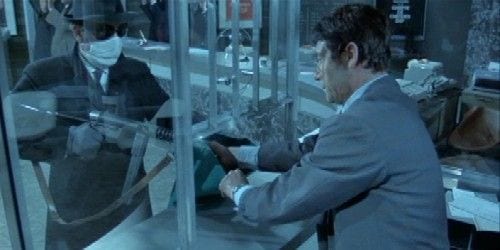
It’s late in the afternoon. A heavy storm on a lonely road by the sea. A car pulls up, windshield wipers moving at a fast, hypnotic pace. An intense wind billows a tan trenchcoat, the man wearing it holding tight to his fedora lest it blow off into the ocean. All is quiet except for the sound of the rain and the wind, the cries of the sea gulls caught in the tempest. Sitting alone on this road is a bank, just minutes before closing. Soon, it will be held up by more men in trenchcoats and fedoras. We are not in Paris or New York or Rome but in the world of French auteur Jean-Pierre Melville, a place made up of images and sounds that are drawn from the vast library of our shared cinematic memory.
Melville was to the American crime film what Sergio Leone was to the American western. Both filmmakers took the archetypes, motifs, and visual iconography of their respective genres and pushed them way past anything resembling realism into almost complete abstraction. The purpose of both filmmakers was to strip the genres down to their most basic, ritualized actions focusing attention not so much on character but on process. In Melville this became such an obsession that his characters were as identifiable by their coats, hats, and sunglasses as much as by their laconic dialogue.
In Dirty Money we are presented with a plot that is clearly the template for Michael Mann’s Heat. Club owner and bank robber Simon (Richard Crenna) and cop Eduard Coleman (Alain Delon) are both very good at their jobs. Both, however, are tired of doing it. Simon’s trying to pull off that “one last job” that’ll set him up for good while Coleman has to stop him, not because he wants to but because that’s what he does. It’s what defines him. That they are friends is beside the point. Coleman betrays that friendship every night he spends in the bed of Simon’s girlfriend, Cathy (Catherine Deneuve). What it comes down to is what it always comes down to in Melville: What is the right thing to do in a world where the line between right and wrong are closer than they should be?
This was Melville’s last film and while not really his best (that honor clearly goes to Le Samourai), it is his most typical. Everything that has come to be known as “Melville” exists in some form throughout Dirty Money‘s 98 minutes. The flaws that are present are the flaws of many of the greatest auteurs’ autumnal works. In these films, there is an obsessive interest in going over the same thematic ground, and a reluctance to give up older forms of cinematic artifice for a more contemporary realism. Hitchcock with his highly theatrical Marnie and Hawks with his second and much stodgier pass at Rio Bravo, Rio Lobo, also turned out old-fashioned entertainments squarely at odds with the new wave of Bonnie and Clyde and The WIld Bunch. For these filmmakers time had stood still, trapped inside the confines of their personal viewfinders.
The English language title is misleading. Dirty Money seems to ask for a wider reading of the story as a tale of characters drawn in by greed and allowing themselves to become corrupted by it as in John Huston’s film of The Treasure of the Sierra Madre. The actual translation of the original title, Un Flic, is, simply, “A Cop”, which parallels perfectly with Melville’s earlier film with Delon, La Samourai. Both films are character studies of lonely men on their own side of the law, each attempting to walk the line between what they need to do to survive and what they believe is honorable. For Melville, the classic cops and robbers crime story was simply a vehicle to place his flawed heroes through ritualized situations of life and death. The situations gave Melville the opportunity to examine the existential questions that underlie such stories. In Hollywood crime films like Raoul Walsh’s High Sierra, these questions would be hidden beneath the slam bang action veneer. But in Melville, the subtext would be moved front and center and his characters would exist in a world defined by it.
Dirty Money comes to DVD from Lionsgate Home Video and it’s simply the best version I’ve ever seen of the film. Presented in its original 1.85:1 aspect ratio and with its very specific, almost monochromatic blue and white color timing, the images pop off the screen. The final image is perhaps the most powerful: a shot of the telephone ringing in Coleman’s office and going unanswered (a conceit picked up years later by his counterpart Leone in Once Upon a Time in America, by the way). For Coleman this is a kind of closure, a “death in life”. It’s clearly a call to a new case, more of the same day-to-day drudgery. But for Melville it’s an open ending, one that promises another story that could’ve been but will never be.

![Call for Papers: All Things Reconsidered [MUSIC] May-August 2024](https://www.popmatters.com/wp-content/uploads/2024/04/all-things-reconsidered-call-music-may-2024-720x380.jpg)



